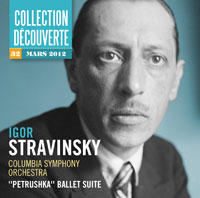Stravinsky Conducts Stravinsky by Paul E. Robinson
/ March 1, 2012
Version française...
Flash version here
 When great composers speak, musicians listen. When Igor Stravinsky, arguably the greatest composer of the Twentieth Century, talks about or conducts his own music, musicians are well advised not only to listen, but also to take notes. Nonetheless, it is not a simple matter for a conductor to serve as a stenographer and merely reproduce what he has heard and written, even when it comes from the composer himself. Stravinsky was much given to pontifical utterances, but in practice he was surprisingly variable and inconsistent. When great composers speak, musicians listen. When Igor Stravinsky, arguably the greatest composer of the Twentieth Century, talks about or conducts his own music, musicians are well advised not only to listen, but also to take notes. Nonetheless, it is not a simple matter for a conductor to serve as a stenographer and merely reproduce what he has heard and written, even when it comes from the composer himself. Stravinsky was much given to pontifical utterances, but in practice he was surprisingly variable and inconsistent.
Stravinsky recorded nearly everything he wrote, and often several times. He supervised piano rolls of both Petrushka and Le sacre du printemps in the early 1920s, then conducted recordings of them in 1928, 1940 and 1960. Developments in recording technology help to explain why he recorded the same pieces so often. But there were other reasons too. As Nicholas Cook observes, “one was Stravinsky’s financial dependence on recording and more generally on conducting, as a result of the drying up of his Russian royalties following the 1917 Revolution.”
What did Stravinsky think of himself as a conductor? Here is what he told Robert Craft in 1958:
Well, reviewers have certainly resisted me in that capacity for forty years, in spite of my recordings, in spite of my special qualifications for knowing what the composer wants, and my perhaps one thousand times greater experience conducting my music than anyone else. (Conversations with Igor Stravinsky)
Stravinsky has certainly left us invaluable documentation of himself conducting his own music. The best sound and perhaps the best performances are to be found in the Igor Stravinsky Edition produced by Columbia Records in the 1960s and released on stereo LPs. This comprehensive series includes interviews with the composer and excerpts from rehearsals. If one wants to see what Stravinsky looked like when he conducted there are plenty of examples on YouTube.
Stravinsky was very precise in marking his scores for publication. He gave metronome markings for every change in tempo. And he often said that his recordings provided further confirmation of what he wanted as to such matters as tempo, articulation, phrasing and balance. However, on his recordings Stravinsky the conductor often took tempi that were different from those indicated in the score by Stravinsky the composer.
Erica Heisler Buxbaum wrote an excellent paper in 1988 comparing Stravinsky’s score and recordings tempi for Le sacre du printemps and concludes, “We cannot unquestionably accept either his metronome markings or his own recorded performance tempi as reliable guidelines.” (Performance Practice Review Vol. 1 No. 1)
For the American magazine Hi-Fi Stereo in 1964, Stravinsky reviewed three recent recordings of Le sacre du printemps. Then again in 1970 he reviewed three more, including one of his own. The conductors represented were Karajan, Boulez (two recordings) and Mehta. Buxbaum, in the above-mentioned article, establishes each conductor’s metronome markings for each section of Le sacre du printemps, compares them to the metronome markings in the score, and the composer’s comments in his reviews. In most cases the conductors deviate only in minor ways from the metronome markings in the score and yet Stravinsky is often very critical. For example, in the Augers of Spring section, Boulez takes a tempo of 56 to the half note when the marking is 50 to the half note, and Stravinsky comments “much too fast.” In the Introduction to Part Two Karajan is called to account—“sleepy tempo”—for taking a tempo of 44-46 to the quarter when the marking is 48, and Stravinsky’s comment on his own recording—which is exactly the tempo marked in the score—is “too fast.” In the Sacrificial Dance (Danse Sacrale) at the end, Stravinsky takes almost the same tempo as Karajan, but Karajan’s is characterized as “sluggish tempo.”
Buxbaum focuses almost entirely on tempi in her article, but in his reviews of various current recordings Stravinsky offers comments on other matters too. On Karajan’s 1963 recording with the Berlin Philharmonic Stravinsky wrote that the performance was “generally odd, though polished in its own way, in fact, too polished, a pet savage rather than a real one…there are simply no regions for soul-searching in the Rite of Spring.” I have no doubt that Karajan was stung by this review. But instead of quietly dropping the piece from his repertoire he took the composer’s comments to heart. He made another recording of Le sacre du printemps in 1977 and it is infinitely better. The tempi are faster, the accents are sharper and the articulation is crisper.
Stravinsky tended to be very rigid about how his music was to be played when he was a young man. But with age, and more experience conducting his own music and making recordings, he came to realize that there are more possibilities than he once thought:
I have changed my mind…about the advantages of embalming a performance on tape. The disadvantages, which are that one performance represents only one set of circumstances, and that mistakes and misunderstandings are cemented into traditions as quickly and canonically as truths, now seem to me too great a price to pay. (Themes and Conclusions, 1969, revised 1971)
For the March Discovery CD, La Scena Musicale and Espace 21 present a historical recording of Stravinsky’s Petrushka. This 1960 recording features the Columbia Symphony Orchestra directed by Stravinsky.
Version française... | 

